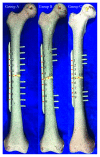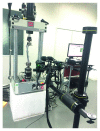Finite Element- and Design of Experiment-Derived Optimization of Screw Configurations and a Locking Plate for Internal Fixation System
- PMID: 31531124
- PMCID: PMC6721095
- DOI: 10.1155/2019/5636528
Finite Element- and Design of Experiment-Derived Optimization of Screw Configurations and a Locking Plate for Internal Fixation System
Abstract
Objectives: The optimization for the screw configurations and bone plate parameters was studied to improve the biomechanical performances such as reliable internal fixation and beneficial callus growth for the clinical treatment of femoral shaft fracture.
Methods: The finite element analysis (FEA) of internal fixation system under different screw configurations based on the orthogonal design was performed and so was for the different structural parameters of the locking plate based on the combination of uniform and orthogonal design. Moreover, orthogonal experiment weight matrixes for four evaluation indexes with FEA were analyzed.
Results: The analytical results showed the optimal scheme of screw configuration was that screws are omitted in the thread holes near the fracture site, and single cortical screws are used in the following holes to the distal end, while the double cortical screws are fixed in thread holes that are distal to the fracture; in the other words, the length of the screws showed an increasing trend from the fracture site to the distal end in the optimized configuration. The plate structure was optimized when thread holes gap reached 13 mm, with a width of 11 mm and 4.6 mm and 5 mm for thickness and diameter of the screw, respectively. The biomechanical performance of the internal fixation construct was further improved by about 10% based on the optimal strain range and lower stress in the internal fixation system.
Conclusions: The proposed orthogonal design and uniform design can be used in a more efficient way for the optimization of internal fixation system, which can reduce the simulation runs to about 10% compared with comprehensive test, and the methodology can be also used for other types of fractures to achieve better internal fixation stability and optimal healing efficiency, which may provide a method for an orthopedist in choosing the screw configurations and parameters for internal fixation system in a more efficient way.
Conflict of interest statement
The authors declare that they have no conflicts of interest.
Figures










References
-
- Nassiri M., MacDonald B., O’Byrne J. M. Locking compression plate breakage and fracture non-union: a finite element study of three patient-specific cases. European Journal of Orthopaedic Surgery & Traumatology. 2012;22(4):275–281. doi: 10.1007/s00590-011-0834-6. - DOI
MeSH terms
LinkOut - more resources
Full Text Sources
Medical
Miscellaneous

